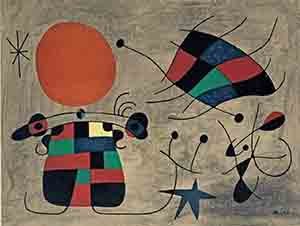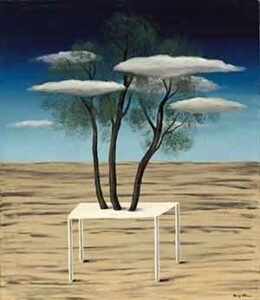This post is also available in: Español (Spanish)
Birth
The Surrealist Movement was born in Paris as a literary movement, which evolved and influenced the arts, and especially painting and photography. André Breton, French writer, publishes in 1924 the first surrealist manifesto, influenced by the theories of Sigmund Freud, who intended to discover the subconscious through the images that emerged from dreams, which challenged the real world. The painters explored the mysteries of the mind, its irrationalities and fantasies, searching a new artistic freedom. The surreal term means to go beyond reality.
Its initiators

Surrealism has a high number of painters, among the most prominent are: Marx Ernst, Miró, Masson, Picasso, Tanguy and Magritte.
There are two trends in Surrealism: the oneiric, of dreams themselves, and automatism, which started from free association. They used photography in which they joined the real and the surreal through photographic techniques. They also used provocative issues, such as violence and sex. Art made it possible to express what the artists had lived after the World War I. And they wanted to achieve new styles and forms of artistic expression.
Giorgio de Chirico (1888-1974) gave rise to what we call metaphysical painting and influenced surrealist painting. He painted real places and objects in strange contexts, resulting in disturbing images. He gave special importance to the world of dreams and the subconscious, and the juxtaposition of objects which was a distinctive note of surrealism. His work turned later into a classicism.
Marx Ernst (1891- 1976), German artist, nationalized French, developed new techniques to express his own unconscious behaviors. The frottage (rubbed a pencil on paper on a surface with irregularities). He made collages using technical and scientific book clippings, worthless. He founded the branch of Dadaism in 1919, which was an artistic movement formed by artists and writers dissatisfied with the atrocities of war. Through their works they rebelled themselves against established art, incorporating irrational and imaginative concepts in their works. He contributed to the development of Surrealism from Dadaism, using childhood memories to influence his works.

Joan Miró (Barcelona 1893-1983). His work is characterized by automatic drawing, transferring the unconscious processes to paper. He was an introspective artist that rejects the traditional conventions of painting. As a playful artist, he gave great value to children’s drawings, although in his work there is a degree of rebellion; he said he wanted to destroy painting, which was a Dadaist concept. Surrealist painters gave great importance to amateur artists, whose painting was based on creative impulses, without aesthetic laws. Also to children’s drawings and painting of sick people … always looking for fantastic or absurd images.
René Magritte (1898-1989). He stood out for a real Surrealism, a great imagination and paradoxical visual statements. In his work The Empire of Light, it can be seen both night and day, a surreal and irrational dream scene.
Salvador Dalí (1904-1989). Owner of an eccentric personality, he joined the surrealist group in Paris. His method that he called critical paranoid, was based on delusional associations. His work explores unconscious desires. He painted unpleasant and surprising images with meticulous realism. In his work The Persistence of Memory, with its melting clocks, he gives us the feeling that time drove crazy.
Expansion
The surrealist movement spread to other nations and had a great influence on film and the world of the arts in general.


.png)